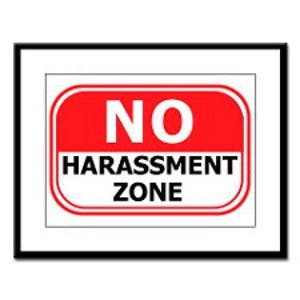Employment laws can be confusing and downright scary.
They don’t have to be. As a public service, from now until my special Halloween webinar Answers to the World’s Scariest Employment Law Questions, I’ll be tackling each major law one by one to give you what you REALLY need to know. By the end, you’ll have handy one-page cheat sheets for each and every law and your terror level will be reduced to zero.
Today’s Topic: Harassment
Here is basically everything you need to know about harassment law in one handy post.
HARASSMENT CHEAT SHEET
What employers are covered?
Employers with 15 or more employees (arises out of Title VII, etc)
What is Quid Pro Quo Harassment?
Certain benefits of employment are conditioned on the victim’s submission to unwelcome sexual advances made by his or her supervisor.
Important notes about Quid Pro Quo Harassment?
- A victim who eventually succumbs to the advances still has a claim;
- The perpetrator of the harassment must be a person with management authority.
- The employer is strictly liable for any proven harassment.
What is a hostile work environment?
It is a workplace that is sufficiently permeated with severe and pervasive insult, intimidation and/or ridicule based on a person’s race, national origin, disability, religion, age or sex such that a reasonable person would find it hostile or abusive.
Important notes about a hostile work environment:
- The environment can be caused by vulgar comments, stories or jokes, offensive documents or postings, or inappropriate physical conduct.
- The environment can be created or contributed to by managerial staff, coworkers and/or customers.
- Employers can avoid liability for a hostile work environment depending on the circumstances.
- It can be based on sex or any other protected characteristic.
How can an employer avoid liability for a hostile work environment?
If the offensive conduct was conducted by a supervisory employee:
- Employer must prove that if exercised reasonable care to prevent and then promptly correct the harassing behavior.
- The victim employee must have unreasonably failed to take advantage of the corrective measures provided by the employer.
If the offensive conduct was by a coworker:
- Employee must prove that employer knew or had reason to know about the behavior but failed to take proper remedial action in order to recover from the employer.
What are the potential penalties?
- Back and front pay;
- Compensatory damages;
- Reinstatement;
- Punitive damages;
- Attorneys’ fees.
Top Harassment tips
- Promulgate and enforce an anti-harassment policy.
- Provide anti-harassment training for all managerial employees.
- Provide a means by which victims of harassment can complain and ensure that employees are aware of the complaint procedure.
- Investigate all claims of harassment.
- If harassment is proven, take steps that are reasonably calculated to prevent any further harassment from occurring, including disciplinary action against the perpetrator(s).
- Refrain from taking any adverse action against the person complaining about harassment.
Stay tuned for more. Tomorrow we’ll de-scare-ify the Health Insurance Portability and Accountability Act (HIPAA).
This was originally published on Manpower Group’s Employment Blawg.
